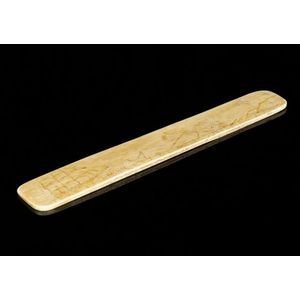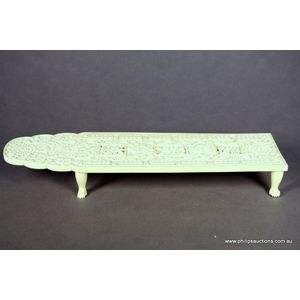19th Century Chinese Ivory Cribbage Board
A fine Chinese export ivory cribbage board, Qing Dynasty, 19th century, the rectangular board with a shaped end, exquisitely carved in relief with arabesques and chrysanthemum flowers, with three central panels comprising figural narratives in pavilion and garden scenes, raised on four zoomorphic feet. Height 3.5 cm. Length 25 cm. Width 8 cm
You must be a subscriber, and be logged in to view price and dealer details.
Subscribe Now to view actual auction price for this item
When you subscribe, you have the option of setting the currency in which to display prices to $Au, $US, $NZ or Stg.
This item has been sold, and the description, image and price are for reference purposes only.
- Qing Dynasty - The Qing Dynasty was the last imperial dynasty of China, ruling from 1644 to 1912. It was established by the Manchu people, who originated from the northeastern region of China. The Qing Dynasty was preceded by the Ming Dynasty and followed by the Republic of China.
- Ivory - Ivory is a hard white material that comes from the tusks of elephants, mammoth, walrus and boar, or from the teeth of hippopotamus and whales. The ivory from the African elephant is the most prized source of ivory. Although the mammoth is extinct, tusks are still being unearthed in Russia and offered for sale.
Ivory has been used since the earliest times as a material for sculpture of small items, both in Europe and the east, principally China and Japan.
In Asia ivory has been carved for netsuke, seals, okimono, card cases, fan supports, animals and other figures and even as carved tusks.
In the last 200 years in Europe ivory has been used to carve figures, for elaborate tankards, snuff boxes, cane handles, embroidery and sewing accessories, in jewellery and as inlay on furniture. Its more practical uses include being used for billiard balls, buttons, and a veneers on the top of piano keys.
The use and trade of elephant ivory have become controversial because they have contributed to Due to the decline in elephant populations because of the trade in ivory, the Asian elephant was placed on Appendix One of the Convention on International Trade in Endangered Species (CITES), in 1975, and in January 1990, the African elephant was similarly listed. Under Appendix One, international trade in Asian or African elephant ivory between member countries is forbidden. Unlike trade in elephant tusks, trade in mammoth tusks is legal.
Since the invention of plastics, there have been many attempts to create an artificial ivory - Zoomorphic - Objects made having the shape, form, or likeness of an animal. For example, the Hindu god Ganesha has the head of an elephant.
The term is also applied to furniture made from animal parts. Examples are chandeliers, hallstands and chairs made from deer antlers and umbrella stands, ice buckets and other objects made from an elephant's foot.
This item has been included into following indexes:
-
games and puzzles, various games
- board games 247
- cribbage boards 19
Visually similar items

A scrimshaw whalebone busk, 19th century, engraved with ships, whales and figures, 22 x 3.5 cm
Sold by
in
for
You can display prices in $Au, $US, $NZ or Stg.

A whalebone and brass ruler, 19th century, 8.7 x 2.7 cm closed
Sold by
in
for
You can display prices in $Au, $US, $NZ or Stg.

American World War II survival knife with a horn handle & leather sheath. 53 cm long
Sold by
in
for
You can display prices in $Au, $US, $NZ or Stg.

A lady's Bueche-Girod 9ct gold bracelet watch with textured brick-pattern links and chevron cover terminal over the concealed dial. Weight (all in) 51.7g
Sold by
in
for
You can display prices in $Au, $US, $NZ or Stg.
